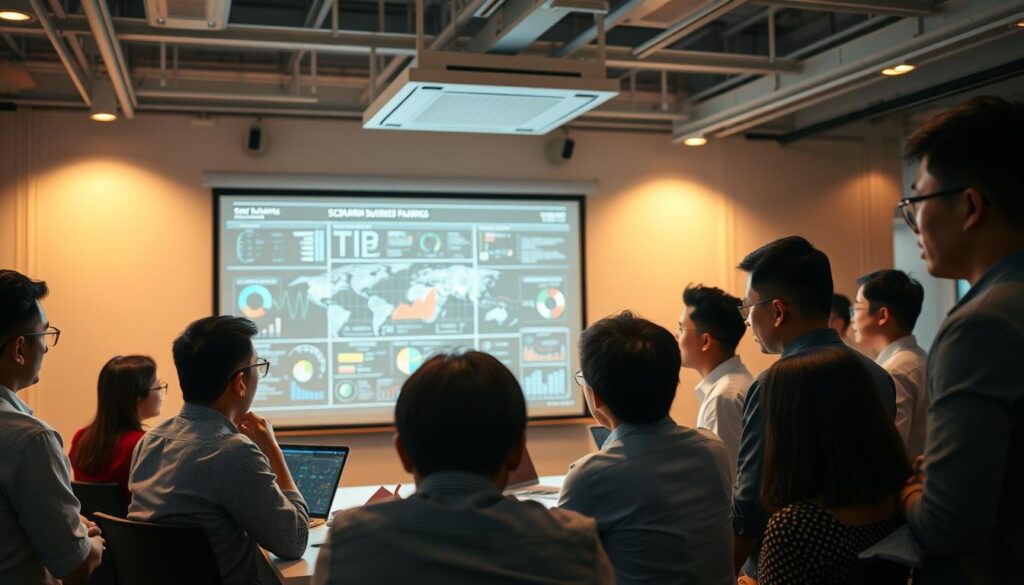In today’s fast-changing business world, a big question is: Are old planning ways enough to protect your company’s future? The COVID-19 pandemic showed us how limited traditional strategies can be. AI scenario planning is a new way to use artificial intelligence to spot trends and build strong strategies.
This method helps businesses see and prepare for possible problems. By using AI, companies can make better decisions and handle tough situations. AI in scenario planning is not just keeping up with changes. It’s about making your business strong against unknowns and growing even when times are hard.
Key Takeaways
- AI scenario planning enhances traditional methods, allowing for better preparation against uncertainties.
- Organizations can leverage predictive analytics for decision making to navigate complexities effectively.
- Integrating AI helps in formulating resilient strategies that respond to emerging challenges.
- The importance of proactive Business Continuity Planning (BCP) has been highlighted by recent global events.
- Effective scenario planning allows businesses to maintain operations during disruptions and ensure quicker recovery.
What is AI-Enhanced Scenario Planning?
AI-enhanced scenario planning mixes advanced AI with traditional forecasting. It helps companies create and check out different future scenarios. This way, they can get ready for both challenges and chances ahead.
Definition and Purpose
The goal of AI scenario planning is to use AI to get deep insights from big data. It makes forecasts more accurate by spotting hidden patterns. This helps companies plan ahead, staying agile and flexible.
Key Benefits
Using AI in scenario planning brings big benefits:
- Speed and Efficiency: It saves time and money, unlike old methods that take a lot of time and cost a lot.
- Improved Accuracy: AI helps make better risk assessments and decisions, adding depth to strategic plans.
- Diverse Scenario Generation: AI makes it easy to create many scenarios without needing to spend a lot on consultants.
- Resilience and Preparedness: Combining human skills with AI leads to better planning for the future.
Brands like Coca-Cola Company, Lumen Technologies, and Autodesk show AI’s power. For example, Coca-Cola boosted its forecast accuracy by 20%. Autodesk cut its forecast time by 80%. These stories highlight AI’s big impact on different industries.

Companies using AI get ahead and innovate. For those interested in AI and planning, AI helps in planning in finance and more.
Importance of AI in Modern Business Strategy
In today’s fast-paced business world, companies face more uncertainty and complexity. Using AI in business strategies is key to tackling these issues. AI helps analyze big data, spotting threats early. This lets businesses move from yearly plans to quick, flexible strategies.
Addressing Uncertainty in Business
Workers spend almost 29% of their week looking for important info. AI can quickly analyze all kinds of data, finding key insights. This lets companies test different scenarios, reducing risks.
With machine learning, businesses can find their way to success. They can spot what’s working and what’s not. This helps make better decisions and stay ahead in the market.
Enhancing Decision-Making Capabilities
AI makes communication and decision-making easier. It breaks down big ideas into steps that can be taken. This leads to quicker, more accurate choices.
AI’s power to handle lots of data helps companies adjust to market changes fast. This boosts performance and finds new ways to save money. Businesses that use AI well see better strategy quality.

Adopting AI insights can make a business more responsive and informed. Companies looking to improve decision-making should look into AI adaptation strategies that fit their goals and abilities.
Techniques for Effective AI-Enhanced Scenario Planning
Organizations aiming to use AI for scenario planning need to focus on key techniques. The first step is collecting and integrating data. This is the base for uncovering important insights. Then, by generating and analyzing scenarios, businesses can explore possible futures and understand their effects.
Data Collection and Integration
Effective AI starts with collecting various data types. This includes market trends, customer actions, and how operations are doing. It’s crucial to prepare for AI by putting this data into one place. This way, businesses get a clear view, making their analysis more accurate.
Having a steady flow of data helps keep plans up-to-date. This lets companies make quick changes to their scenario planning.
Scenario Generation and Analysis
AI makes scenario generation better by using the latest data. It moves away from old methods that rely on past data. AI lets companies try out different scenarios to see how they might play out.
It uses predictive analytics to spot trends and risks. This gives businesses a head start on planning. By looking at different scenarios, companies can make plans that fit with future changes and goals.

AI and Scenario Planning: Preparing for Future Business Challenges
AI makes scenario planning clearer for businesses. It lets them explore different futures and plan their operations. This way, they get better at facing future challenges.
Exploring Uncertainties with AI
AI helps spot risks early in planning. It uses smart algorithms to predict market changes and disruptions. This helps avoid big problems.
It’s key to keep scenarios up to date. This keeps the business learning and ready to adapt.
Developing Robust Strategies
AI and scenario planning help create strong strategies. They let businesses quickly respond to new challenges. This leads to better decisions and more opportunities.
Using detailed scenarios in plans makes businesses more agile. They can change direction when needed. This makes the business more efficient and confident.
Implementing AI for Risk Management
Adding AI to risk management is key for companies wanting to spot and tackle risks early. With these tools, businesses can better analyze past data and market trends. This helps them understand what could harm their operations.
Identifying Potential Risks
AI is crucial in spotting different risks like operational, financial, and cybersecurity threats. It uses algorithms to find odd patterns and predict risks before they get worse. By following standards like ISO 31000, companies can make sure their risk checks are thorough and systematic.
Using frameworks like the NIST AI Risk Management Framework helps too. It looks at both the technical and social sides of AI risks.
Developing Mitigation Strategies
Once risks are found, companies need to come up with plans to fix them. AI helps by looking at data and suggesting ways to lower risks. It might suggest changing how things are done or moving resources around.
Having humans check important decisions is also key. This way, AI’s suggestions can be reviewed and adjusted. Keeping an eye on AI systems and checking their performance often is also important. Following best practices in using AI makes these efforts more effective.
| Type of Risk | AI Identification Methods | Mitigation Strategies |
|---|---|---|
| Operational | Data pattern analysis | Adjusting workflows, resource reallocation |
| Financial | Anomaly detection in transactions | Fraud detection systems, behavior analysis |
| Cybersecurity | Threat detection algorithms | Regular security audits, employee training |
| Regulatory | Compliance checks through AI | Regular updates to policies and frameworks |

AI Future Readiness: Preparing for Tomorrow
In the fast-changing world of artificial intelligence, companies must get ready for the future. A strong artificial intelligence strategy helps them face new challenges and grab new chances. By linking AI plans with their goals, businesses build a solid base for growth.
This strategy boosts work efficiency and gets companies ready for the future’s complexities.
Building Resilient Organizations
Creating a strong organization means knowing how to use AI well. About 76% of IT leaders think generative AI will be key for their teams. This shows how crucial it is to check both tech and people plans for AI readiness.
Companies should look at their AI skills through a readiness check. This check should cover finding new chances, managing data, and keeping things secure. Spotting weaknesses in these areas helps use AI fully and meet future rules.
Aligning AI with Strategic Goals
To match AI with goals, companies need a wide plan. This includes training workers and updating rules. If AI is not ready, it might not follow new rules, causing problems.
Using the OECD AI Principles helps make AI trustworthy. It also helps keep everyone involved and makes rules flexible. By following these principles, companies can innovate while being ethical, leading to lasting success in the AI world.
Real-World Applications of AI-Enhanced Scenario Planning
AI scenario planning has changed many industries, like those in Southeast Asia and tech. It helps companies use predictive analytics for AI in real-time. This gives them a big advantage. Here are some examples of how it works.
Case Studies from Southeast Asia
A big tech company in Southeast Asia used AI to guess market trends and what people want. They used predictive analytics for AI to quickly change their products. This made them more popular and happy customers.
Insights from the Technology Sector
An auto company used AI to avoid supply chain problems. They used AI to manage their stock and make things better. This made them ready for surprises and kept their business running smoothly.
| Industry | Company | Application | Outcome |
|---|---|---|---|
| Technology | Unnamed Tech Company | Forecasting market trends | Increased market share and customer satisfaction |
| Automotive | Unnamed Automotive Firm | Supply chain disruption management | Optimized inventory, improved production efficiency |
Challenges in AI Scenario Planning
Businesses face many challenges when using AI for planning. Data privacy and security are big concerns. They must follow rules and protect sensitive data. AI uses a lot of data for better predictions.
Companies need to make sure their systems can work well with AI. This means checking their tech and training staff. The “six E” principles can guide them through these steps.
The market is always changing, and AI can affect businesses a lot. Overcoming these challenges helps companies get ready for new situations. With the right plan, they can use AI to their advantage and stay strong.

